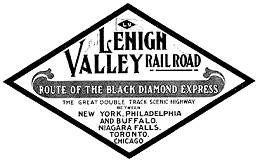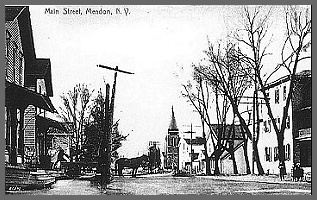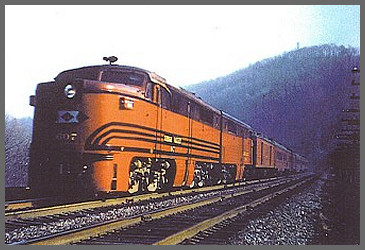| Back to Home Text | Back to LV Depot |
 |
A Slice of Nostalgia in Mendon, New York |
| It's the dawn of the 1950's in a tiny corner of rural America, the sleepy hamlet of Mendon, New York. Two sets of heavy steel rails traverse the scene, arriving from the northeast along Mill Street, slicing the Pittsford road and curving smartly across the direct road to Rush. Shiny from frequent use, the iron trail portends that quietude is anything but when the Lehigh Valley Railroad drags a string of passenger or freight revenue through town. |  |
| By 1950, the Lehigh had emerged from World War II tattered from its patriotic effort and hardly the romantic image of steam engines ferrying passengers from every backwater station it served. Mendon, like so many lesser burgs, had been deleted from Lehigh passenger timetables and rarely occasioned a freight assignment. However, the tracks stayed burnished from long-distance diesel-powered engines tugging lengthy east or westbound consists. Regardless of the hour - high noon or well past midnight - the trains kept a steady procession. |
| On weekday mornings, Train #11, "The Star," traversed Mendon doing at least seventy, sweeping westward past the recently abandoned depot, hauling people, express and mail from New York City's Penn Station to the LV's colonnaded Buffalo terminal. Later, as the noon hour approached, the venerable "Black Diamond Express," the famous passenger varnish celebrated since the 1890's, turned the becalmed hamlet into a flash of Cornell Red. |  |
| A shrieking chime horn and heavy rumble shook every material thing nearby, as it sped hurriedly down the eastbound track toward Victor, Geneva and, eventually, New York City. As the buzz dissipated from the Star whistling by heading toward Rush, Batavia and Buffalo, a diminutive lady and two little boys were revealed on the station platform. At the instant of the train's passing, a gray canvas bag, hanging tautly from a trackside post, disappeared as the car immediately behind the locomotive whooshed past. |
| Hard by the Irondequoit Creek bridge on the Victor highway, Grace Habecker held sway at Howard's in more ways than one, for it was often her job to fill her husband's soda jerk shoes. But she had U.S. Government tasks to perform as well, since those cubby hole box affairs in the rear of the store comprised the Mendon Post Office and Grace was its erstwhile postmistress. With the arrival of the trio and their cargo, another exchange of U.S. Mail with the Lehigh Valley Railroad had been completed. Mrs. Albert Alexander, her boys Joe and Butch, and their little red wagon had just traded mailbags with hundreds of tons of screaming railroad train doing 70 miles-per-hour. It was a now-extinct slice of Americana, performed thousands of times a day without fanfare, in fair weather and foul, in mid-20th Century America. Marguerite Alexander, a young mother with two (subsequently three) children in tow, spent nearly four years (1950-53) transferring mail between Mendon's post office and its railroad depot. Together with her husband, who helped with evening parcel post and 1st Class mail deliveries to and from nearby Rochester Junction, the Alexanders, at $50 monthly, experienced a microcosm of the intricate and historical web with the U.S. Mail system. Born out of the colonial days of horseback mail delivery were two fascinating institutions: "Rural Free Delivery" (R.F.D.), which reached the far-flung rural folk of the hinterlands not served by a community postal facility and the "Railway Post Office" (R.P.O.), when most of the activities within a community post office were carried out on specially outfitted cars of the "Railway Mail Service," moving along America's vast railroad network. While the R.F.D. system came late to the scene (a carrier out of nearby Elba, N.Y. traversed the first route in the nation in 1896), railroads were designed into mail delivery schemes way back in the 1830's. A fledgling means of transportation in those days, it was not until the Civil War that mail was sorted onboard trains. Though slow to catch the fancy of railroaders, public imagination was immediately captured via songs, plays and even a railway clerk correspondence school. The first fast mail train in the U.S. was a 26-hour run from Grand Central Station to Chicago over the New York Central Railroad in 1875. It included 100 "scoops" of mail from depots along the way, a loading of New England mail during a quick stop at Albany and thirty-three tons that originated in New York City - all sorted and bagged enroute for further distribution out of Chicago. While the "Fast Mail" was the glamour, railroads furnished hundreds of workhorse R.P.O. cars that plied the branches connecting small-town America with the major urban centers. By 1888, at salaries of $900 to $1,300 a year, postal clerks ranged over 26,000 miles of track, logging 122,000,000 railroad miles yearly. Long hours, fatigue and front office whims were the benefits, with a bonus that, with mail cars at the headend of trains, Railway Mail Service rosters suffered terrible casualties in accidents. It was high drama, as Marguerite would attest, when a speeding train's "catching post" snatched a mailbag from a depot stanchion, whereupon postal clerks within the R.P.O. car stamped and sorted flats at lightning speed while rocking to the clickity-clack song of the rails. Strictly from Marguerite Alexander's trackside viewpoint, Mendon could hardly be considered a major player in the Lehigh Valley's scheme of things. That is not to say, however, that periodic train racket was the only excitement that visited the little depot or the highway crossings that framed it at each end. To be sure, every rail line had a sordid history of tragedy and the mainline hamlet of Mendon was no exception. Numerous fatalities occurred at its twin grade crossings, when locomotives indiscriminately victimized riders of wagons, buggies, cars and trucks, as well as pedestrians. Specifically, the very routine of hauling the mail to or from a main train rendezvous was broken at least twice at Mendon; in 1921, when the LV's crack fast mail train plastered a car at the unguarded crossing east of the station, resulting in one death, and, in 1938, when a Mendon woman, performing the exact task of transferring the mails as Marguerite has done so many times, misread the approach of the Black Diamond and died - along with the stationmaster's little boy, who had accompanied her. The latter event was most shocking to the close-knit community. Just before noon on a cheerfully bright Wednesday in June, 75-year-old Mary Schlaefer was at the station to retrieve the mailbag tossed from the Diamond on its eastward roll toward New York City. She was substituting for her daughter, Lillian, having done so on numerous occasions. The elderly woman had lately been joined by 18-month-old Robert Slaght on her rounds between the station and the Schlaefer home/post office just east of the Grange Hall. Leland Slaght, recent successor to the veteran Mendon agent, Darwin Turner, never doubted for little Robert's safety when, in the lady's arms, the two began crossing the tracks to await the onrushing train. Coasting on the downhill grade over the Rush-Mendon Road, the steam-powered Black Diamond fooled Mrs. Schlaefer as it swiftly rode the gentle curve toward the station. The alert engineer spotted her dilemma and clanged the warning bell - its peal of emergency bringing all residents within earshot sprinting toward the tracks. In horror, both Agent Slaght and his wife realized Mary's blunder too late and their cries were drowned out by the shrieking whistle and wheels of the train. Gate-tender Addison Hodge heard the bell and spotted the danger from his shanty at the Pittsford Road crossing one hundred yards up the line, but there was nothing he could do.
Web Site Hosting by TRAIN WEB The WNYRHS, Inc. P.O. Box 416, Buffalo, NY. 14231-0416 is an independent organization and has no affiliation with any other local or national group. |